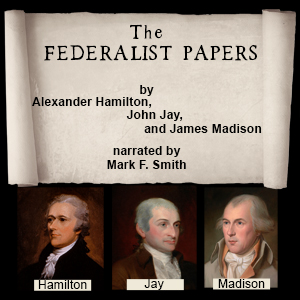
“The Federalist Papers” are a collection of 85 linked essays that explain the construction of the U.S. government and why it was built that way. The Papers are regarded as the best pipeline into understanding the U.S. Constitution and the founding principles of the government it would establish.
I have endeavored here to present these essays, not as articles in a newspaper, but as you might have experienced them if you had sat in a comfortable tavern with a tankard in hand, and listened while these ardent men ranged in front of a friendly fireplace as they attempted to convince you of their arguments.
Following the Revolutionary War, the newly-independent United States of America were organized under the Articles of Confederation. This well-intentioned document was faulty to the purpose, and the new nation rapidly found itself in dire financial distress.
Consequently, in 1787 a Constitutional Convention was called to produce a new blueprint for the government. After completion, that plan was sent to the States in September of that year for ratification, but it immediately came under fire for the powers it granted to the central government.
In New York, views on either side were heated. To persuade the public to support the Constitution for ratification, Alexander Hamilton (who had been a delegate to the Convention) and John Jay (who had helped negotiate the treaty with Great Britain that ended the War), began a series of anonymous essays to educate the citizenry in how the government would be arranged, and why those choices had been made. Later, when Jay was rendered unable to continue by an attack of rheumatism, Virginian James Madison (another Convention delegate who was in New York, serving in the Confederation Congress) was recruited to fill in.
Each wrote essays that were signed “Publius,” the name of a general who had helped to found Rome, to conceal their identities, which might have led to difficulties as Hamilton and Madison had been inside the deliberations at the Convention. These essays were published serially in New York newspapers, eventually reaching the total of 85. (Summary by Mark Smith)

Other Audiobook
Audiobook: Story of a Calico Clown
The Calico Clown and the other toys in the toy shop are planning a night
Audiobook: Seven Lamps of Architecture
The Seven Lamps of Architecture, published in May 1849, is an extended essay written by
Audiobook: Bible (WNT) NT 03: Luke
Richard Francis Weymouth was born on October 26, 1822 near Plymouth Dock, now known as
Audiobook: Lives of the Most Eminent Painters, Sculptors and Architects Vol 7
The Lives of the Most Excellent Italian Painters, Sculptors, and Architects, from Cimabue to Our
Audiobook: Following the Color Line
Subtitled “An Account of Negro Citizenship in the American Democracy”, we are presented an in-depth
Audiobook: Sammlung deutscher Gedichte 024
Eine Sammlung von 20 deutschen Gedichten für LibriVox.
Audiobook: Ausgewählte Gedichte
Adam Oehlenschläger war ein dänischer Dichter, der zu seiner Zeit äußerst populär war, inzwischen aber
Audiobook: The Brilliant Proof (Burhäne Lämé) in reply to an attack upon the Bahai Revelation by Peter Z. Easton
“In these days,” writes the renowned Bahá’í scholar, Mírzá Abu’l-Fadl, “which are the latter days
Audiobook: Izaak Walton’s Lives Of John Donne, Henry Wotton, Richard Hooker and George Herbert
The full title of Walton’s book of short biographies is, Lives of John Donne, Henry
Audiobook: Bible (KJV) 01-03: Genesis, Exodus and Leviticus
The King James Version is an English translation of the Christian Bible begun in 1604
Audiobook: Symposium (version 2) (dramatic reading)
In one of Plato’s more accessible works, Apollodorus tells a friend about a drinking party
Audiobook: Japanese Girls and Women
A clear and delightful peek into the world of Japanese girls and women of the